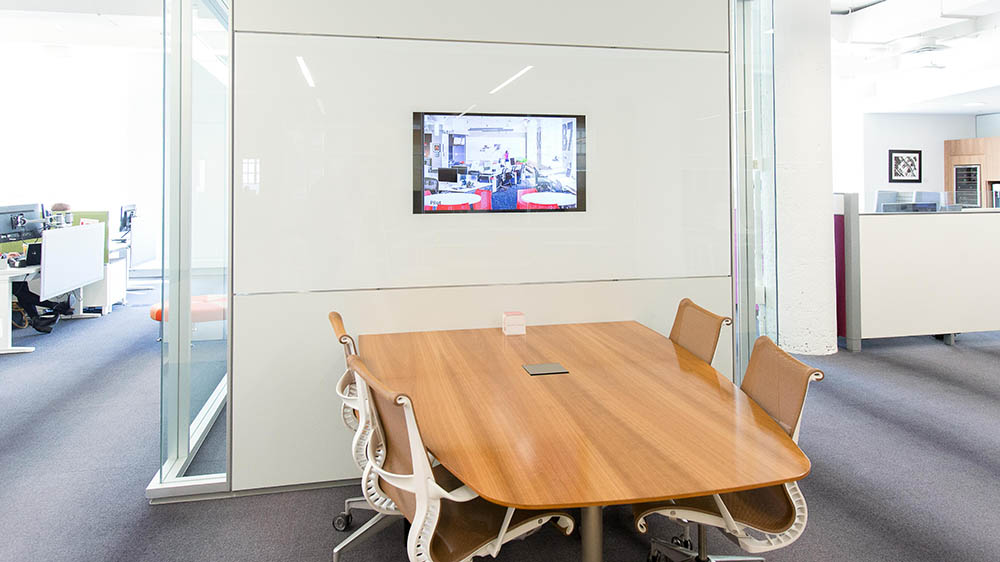How Huddle Rooms are Worth Your Time


Huddle room deployment is akin to copying and pasting the same information from space to space, said David Shamir of Atlona. They’re everywhere! Or at least, everybody seems to want one, or a few, or a lot. But huddle rooms, by definition, are pretty low-key when it comes to technology; therefore, they can’t command the same level of design fees that AV integrators apply to more sophisticated meeting spaces. Still, clients want to huddle, and if you don’t provide them the means to do so, someone else will. The question is: how do AV integration firms make these projects profitable?
It’s a somewhat tricky question because in many cases, large enterprises don’t enlist integrators to install huddle room equipment. “Huddle technology very often—not always, but in its simplest, most basic form—is installed by the internal IT guys, and telephony guys, and smart people who are not experts in collaboration and AV, but [who] know very well how to install technology devices,” said Ira Weinstein, senior analyst and partner at Wainhouse Research, a unified communications and collaboration market research firm. These organizations may purchase their huddle room tech from AV integrators, but the buck stops there.

Ira Weinstein, Wainhouse Research

David Shamir, Atlona Happily, not all companies wish to burden their internal IT staff with huddle room installations, and this is where Weinstein counsels AV integrators to adopt a deployment method based on volume and efficiency. “[With huddle rooms,] you’re done in an hour,” he said, especially if you’re rolling them out in the same building. If you can do, say, six a day, the cost of integrating one room is a lot lower than if you’re installing them piecemeal.
David Shamir, director of product management at Atlona, said that this is the reasoning behind the huddle room solutions that his company provides. “What we offer today are tools that enable the systems integrator to duplicate the designs in no time,” he said. In many cases, according to Shamir, deployment is akin to copying and pasting the same information from huddle space to huddle space. “It’s as simple as that—it’s just duplicating designs and setting configurations and setups by using software tools that manage the whole installation holistically.”
This may sound like a fast-food approach to AV integration—something many firms shy away from—but Weinstein argues that these installations will lead to more complex projects down the road. “Once you recognize that, you just turn the crank and do as many as you can for as many clients [as you can] because if they need you for those rooms, they’re going to need you for the next type of room, which is a little more complicated—and the room above that, which is a little more complicated,” he said. The term “trusted partner” may be overused, but it applies well to this scenario.

David Danto, IMCCA David Danto, director of emerging technology at IMCCA, an association focused on providing education on the collaboration and unified communications industry, points out that huddle rooms also offer AV integrators the opportunity to generate recurring revenue through the supply of security-related services. “If you go to a company as an integrator and say, ‘I will take your 3,000 global spaces, or your 100 spaces in this area, and I will, quarterly, come in and make sure that all your systems are patched, that you have no vulnerabilities, and that the firmware updates have been done… companies will find the money to be protected from these bots, and malware, and all the stuff we’re all worried about,” he said. AV integrators, he argues, are well positioned to offer these kinds of services, provided that AV manufacturers supply the regular patches and updates required for this to be possible. “[You can say] ‘Here’s my annuity plan to sell you the security protection so that you don’t have to be chasing down this malware. I’ll chase down this malware for you.’ ”
A daily selection of the top stories for AV integrators, resellers and consultants. Sign up below.
While AV integrators may regard huddle room projects as too low-margin for their time, Weinstein encourages them to view these spaces as an opportunity to incorporate a new business model into their organizations. This is the occasion, he said, to develop an e-commerce infrastructure through which AV firms can sell certain devices through custom portals that make it easier for customers to purchase through them, rather than elsewhere. Promotions, like “buy 10 huddle rooms, get the 11th integrated for free,” can also apply to this, he adds. “This is just a different model—it’s not better or worse—and we recommend that integrators add it to what they do for a living. Don’t look at it like it’s not worth your time. Your customers need it, and there’s money to be made.”
Carolyn Heinze is a freelance writer/editor.
AV is IT (And it’s Not…Yet)
While AV/IT convergence is no longer news, there are still glitches in the system, and David Danto, director of emerging technology at IMCCA, observes that this is due to history: AV and IT followed different evolutionary paths.
“The reality that needs to be faced is that all of our AV products are IT products—but they didn’t start that way,” Danto said. “Had they started that way, they would be managed the same way all of the IT products are being managed. The virtual machines in data centers, the cloud providers, all of the standard IT servers and components went through this rigorous cycle of: how do we get robust? And how do we make sure that we’re redundant? And how do we make sure that we can go through a patch cycle around change control? Those are the things that took years to mature to get to where they are right now. And what we did is we took an analog switching device and slapped an IP port on it—it never came up through that rigorous process. So now we have all these unmanaged IT products out there and no strategy for managing them. That’s where the money will be made.”
—C.H.
Carolyn Heinze has covered everything from AV/IT and business to cowboys and cowgirls ... and the horses they love. She was the Paris contributing editor for the pan-European site Running in Heels, providing news and views on fashion, culture, and the arts for her column, “France in Your Pants.” She has also contributed critiques of foreign cinema and French politics for the politico-literary site, The New Vulgate.
